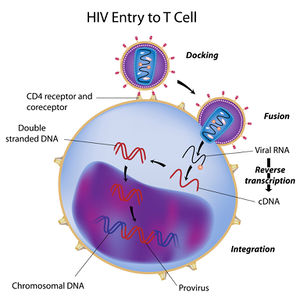HIV/AIDs in the U.S.: Difference between revisions
Chavezerazoj (talk | contribs) No edit summary |
Chavezerazoj (talk | contribs) No edit summary |
||
| Line 55: | Line 55: | ||
[10] | [10] | ||
<br><b>Superscript:</b> Fe<sup>3+</sup> | |||
<br><br>Authored for BIOL 291.00 Health Service and Biomedical Analysis, taught by [mailto:slonczewski@kenyon.edu Joan Slonczewski], 2016, [http://www.kenyon.edu/index.xml Kenyon College]. | <br><br>Authored for BIOL 291.00 Health Service and Biomedical Analysis, taught by [mailto:slonczewski@kenyon.edu Joan Slonczewski], 2016, [http://www.kenyon.edu/index.xml Kenyon College]. | ||
Revision as of 15:23, 18 December 2015
By J. Sebastian Chavez-Erazo
An Introduction to HIV/AIDs

Human Immunodeficiency Virus (HIV) is a harmful retrovirus that, if left untreated, will lead to Acquired Immunodeficiency Syndrome (AIDS) in humans. HIV works by attacking specific cells in the immune system: CD4 cells or T cells. HIV destroys these immune system cells enough over time that the body can not protect itself against infections and disease. The final stage of HIV infections is characterized by AIDS where the immune system is damaged enough that it becomes vulnerable to opportunistic infections. An opportunistic infection or a combination of them are the most likely cause of death in AIDS patients. If left untreated, individuals living with AIDS who are diagnosed with an opportunistic illness have a life expectancy of about one year.
A Basic explanation of Antiretroviral Treatments
Include some current research, with at least one figure showing data.
Pre-/Post-Exposure Prophylaxis
In recent years, pre-exposure and post exposure prophylactic treatments for populations at high risk for Human Immunodeficiency Virus (HIV) infection have become increasingly studied and emphasized as vital to the decreased transmission of HIV resulting in decreased rates of Advanced Immunodeficiency Syndrome (AIDS) development in differing world populations.
Pre-Exposure Prophylaxis
PrEP has given a specific population the opportunity to have a 90% reduction in the chance of contracting HIV with the use of the daily pill, Truvada (oral emtricitabine (FTC)/ tenofovir disoproxil fumarate (TDF)). The product is said to be available to any person regardless of their sexual and gender identity but in there lies the problem with PrEP, many people who are at high risk of contracting HIV are not receiving it.
.
Post-Exposure Prophylaxis
Include some current research, with at least one figure showing data.
Challenges to HIV/AIDs Prevention and Treatment
The product [PrEP] is said to be available to any person regardless of their sexual and gender identity but in there lies the problem with PrEP, many people who are at high risk of contracting HIV are not receiving it.
Conclusion
References
[9]
[10]
Superscript: Fe3+
Authored for BIOL 291.00 Health Service and Biomedical Analysis, taught by Joan Slonczewski, 2016, Kenyon College.
